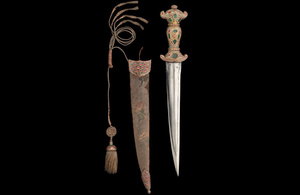A Mughal dagger and scabbard worth over £1 million at risk of leaving UK
A temporary export bar has been placed on a Mughal Dagger and Scabbard worth over £1 million

A temporary export bar has been placed on a Mughal Dagger and Scabbard worth over £1 million
- Bar is to allow time for a UK gallery or institution to acquire the work
- The Dagger and Scabbard was likely acquired by Clive of India after his famous victory at the Battle of Plassey in 1757
A Mughal Dagger and Scabbard is at risk of leaving the country unless a UK buyer can be found to save the work for the nation. Owned by Robert Clive, an important figure in British India, and collected during his time in India, the dagger is likely to have been acquired by Clive in 1757 following his victory at the Battle of Plassey.
Valued at £1,120,000, the dagger has an unusually formed jade hilt with an unparalleled arrangement of precious stones, some of considerable size, whilst the blade is a fine example of Indian watered steel. Dating back to 1650, the silk brocade cover on the wooden scabbard is Iranian, demonstrating the influence of Iran on India throughout the Mughal period.
The fact that this dagger has retained all its components, including the precious stones, is exceptional.
Culture Minister Caroline Dinenage said:
This beautiful example of a Mughal Dagger and Scabbard has a lot to teach us about both the British in India and the nature of diplomatic gifts at the time.
I hope a UK-based buyer is found so this magnificent item can be studied and enjoyed for years to come.
The Minister’s decision follows the advice of the Reviewing Committee on the Export of Works of Art and Objects of Cultural Interest (RCEWA). The committee agreed that this is a fascinating object and illustrative of the culture of court etiquette and diplomatic gift-giving observed at the Imperial and regional courts in 18th Century India. Despite the undeniable controversial figure of Robert Clive, the object is hugely important to the study of the history of the British in India.
Committee Member Peter Barber said:
This fabulously ornate dagger and scabbard shed outstandingly important light on the nature of Anglo-Indian diplomatic relations in the mid eighteenth-century and on the personality of Robert Clive.
The flamboyantly adorned hilt of the dagger is stylistically atypical of Moghul workmanship. Revealingly for the mentalities of the time, it may have been altered, and enriched, to resemble what the imperial or princely donor - trying particularly hard to flatter and win influence with its all all-powerful recipient - thought looked European and thus familiar to Clive. The very splendour of the dagger and its embroidered hilt – and the fact that the precious stones have not been removed as was usually the case with diplomatic gifts – also provides important evidence in the ongoing re-assessment of Clive’s personality and conduct.
I hope they can be retained in this country so that they can be researched as they deserve and can, when displayed, illustrate an important chapter in the long story of the UK’s involvement with the Indian subcontinent.
The RCEWA made its recommendation on the grounds that its departure from the UK would be a misfortune because it was of outstanding significance for the study of 18th century Mughal weapons.
The decision on the export licence application for the piece will be deferred until 8th October 2021. This may be extended until 8th February 2022 if a serious intention to raise funds to purchase it is made at the recommended price of £1,120,000.
ENDS
Notes to editors
- Organisations or individuals interested in purchasing the dagger should contact the RCEWA on 0845 300 6200.
- Details of the dagger are as follows: Dagger and scabbard Mughal, c. 1700-1759 (the silk fabric covering the scabbard Iran, c. 1650) The dagger with watered steel blade, nephrite jade hilt set with rubies and emeralds in gold; the scabbard of wood covered with silk brocade, the nephrite jade locket and chape set with rubies in gold, and tassel and threads of silk and metal Dagger: L 39.5 cm Scabbard: L 30 cm The condition of the jewelled jade components is excellent; the condition of the silk scabbard covering, threads and tassel are relatively good given their inherent fragility.
- Provenance: Acquired in India by Robert Clive, 1st Baron Clive, KB, FRS (1725-1774); inherited by his son, Edward Clive, 2nd Baron Clive of Plassey and 1st Earl of Powis (1754-1839). By descent to George Charles Herbert, 4th Earl of Powis (1862-1952), by descent to his son Mervyn Horatio Herbert, Viscount Clive, 17th Lord Darcy de Knayth (1904-43). Upon his death it passed to the Styche Estate and Trust until 2014; purchased by current owner.
- The Reviewing Committee on the Export of Works of Art and Objects of Cultural Interest is an independent body, serviced by The Arts Council, which advises the Secretary of State for Digital, Culture, Media and Sport on whether a cultural object, intended for export, is of national importance under specified criteria.
- The Arts Council champions, develops and invests in artistic and cultural experiences that enrich people’s lives. It supports a range of activities across the arts, museums and libraries – from theatre to digital art, reading to dance, music to literature, and crafts to collections.